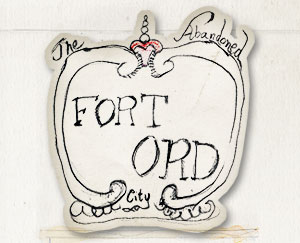 |
 |

A Passage from Fort Ord: A Chapbook Adventure by Steven Foundling and Andy Warner (2008):
Fort Ord was named for Major General Edward Ortho Cresap Ord, a mustachioed mathematical genius, rumored descendent of King George IV and veteran of the Seminole, Indian and Civil Wars. Ord first came to California in the company of William Tecumseh Sherman and Henry Halleck, sailing around Cape Horn in 1847 to the Presidio of Monterey, where he served as First Lieutenant. The gold rush-inflated cost of living forced Ord to take a second job as a surveyor to supplement his army income, eventually mapping much of what would become the city of L.A. His Plan de la ciudad de Los Angeles is one of the few documents available to historians documenting the mid 19th century Pueblo of Los Angeles. He retired from the military in 1880, aged 52, and picked up a contract job building railroads in Mexico. En route from Vera Cruz to New York in 1883, Ord contracted yellow fever and died in Havana.
The Fort occupies roughly 28,000 acres of prime California beachfront. That is the size of San Francisco, give or take a few miles. Monterey Bay hooks around to its south, giving the intrepid sand dune climber a magnificent view of the city and ocean. Fort Ord has its roots in the First World War, part of a massive expansion of the US Armed Forces. Faced with swelling from 200,000 regulars in 1916 to 2 million draftees in a space of two years, the Army purchased immense tracts of land across the nation, including the 15,000 acre Gigling Reservation that would later become Fort Ord in 1933. General “Vinegar Joe” Stilwell, so named for his notoriously quarrelsome nature, oversaw significant expansion of the Fort in August 1940, a response to the growing threat of war. Fort Ord swelled from 15,000 to 20,000 acres and the 7th Infantry, nicknamed the “Bayonets,” was reactivated and stationed there. German prisoners of war, brought back by the thousands from the European theater after D-Day, were used to build new bunkers and walls. North and south, the cities of Marian and Seaside sprung up to meet the Fort’s increasing housing and service needs. In the post-war 1950s, Fort Ord began to be repurposed as a training facility, a role it would occupy for the next three decades. The Fort’s importance increased dramatically during the long years of the Vietnam War when it became the chief training center in the nation. [It was also the first racially integrated base in the nation]. In the face of escalating public opposition to the war in 1969, Fort Ord closed itself to outsiders. In 1970, after Nixon’s expansion into Cambodia, 3,000 demonstrators were turned away from the Fort at rifle point.
Between 1940 and 1975, when Fort Ord ceased activities as a basic training center, an estimated 1.5 million young men [and women] were trained in its sturdy bunkers. Immense size called for extensive facilities and by 1963, the Fort was equipped with an 18-hole golf course, two movie theaters, a twelve lane bowling alley (complete with military bowling leagues), a boxing ring, a sauna, a heated indoor pool, tennis courts and a thrift shop. 23 chaplains at 11 chapels, the largest of which would seat 700, tended to the spiritual needs of the soldiers. Four elementary schools, a preschool and junior high took care of their children...
Fort Ord’s old unit, the 7th Infantry, spent two decades on foreign soil before being deactivated in 1971. They returned to Fort Ord three years later, reactivated as a Light Infantry division… In 1989… while the 7th Infantry was in Panama… the Base Realignment and Closure process began assessing military holdings. In 1991 the BRAC recommended that Fort Ord be shut down. Like the gold rush that forced Major General Ord to survey Los Angeles, the booming California real estate market had driven the cost of living and location far too high for the military. In 1994, the Fort was officially closed and the 7th Infantry deactivated with it. By strange coincidence, one of the last actions the Bayonets engaged in was the quelling of the 1992 L.A. riots, a police action in the very place Major General Ord had mapped a century and a half before. (8 – 12)
Foundling, Steven and Andy Warner, Fort Ord: A Chapbook Adventure into the Ruins of the American Military-Industrial Complex, Indrind Press, 2008.